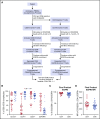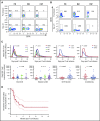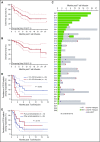Intent-to-treat leukemia remission by CD19 CAR T cells of defined formulation and dose in children and young adults
- PMID: 28408462
- PMCID: PMC5482103
- DOI: 10.1182/blood-2017-02-769208
Intent-to-treat leukemia remission by CD19 CAR T cells of defined formulation and dose in children and young adults
Abstract
Transitioning CD19-directed chimeric antigen receptor (CAR) T cells from early-phase trials in relapsed patients to a viable therapeutic approach with predictable efficacy and low toxicity for broad application among patients with high unmet need is currently complicated by product heterogeneity resulting from transduction of undefined T-cell mixtures, variability of transgene expression, and terminal differentiation of cells at the end of culture. A phase 1 trial of 45 children and young adults with relapsed or refractory B-lineage acute lymphoblastic leukemia was conducted using a CD19 CAR product of defined CD4/CD8 composition, uniform CAR expression, and limited effector differentiation. Products meeting all defined specifications occurred in 93% of enrolled patients. The maximum tolerated dose was 106 CAR T cells per kg, and there were no deaths or instances of cerebral edema attributable to product toxicity. The overall intent-to-treat minimal residual disease-negative (MRD-) remission rate for this phase 1 study was 89%. The MRD- remission rate was 93% in patients who received a CAR T-cell product and 100% in the subset of patients who received fludarabine and cyclophosphamide lymphodepletion. Twenty-three percent of patients developed reversible severe cytokine release syndrome and/or reversible severe neurotoxicity. These data demonstrate that manufacturing a defined-composition CD19 CAR T cell identifies an optimal cell dose with highly potent antitumor activity and a tolerable adverse effect profile in a cohort of patients with an otherwise poor prognosis. This trial was registered at www.clinicaltrials.gov as #NCT02028455.
© 2017 by The American Society of Hematology.
Figures




Comment in
-
Equal opportunity CAR T cells.Blood. 2017 Jun 22;129(25):3275-3277. doi: 10.1182/blood-2017-04-779983. Blood. 2017. PMID: 28642356 Free PMC article.
References
Publication types
MeSH terms
Substances
Associated data
Grants and funding
LinkOut - more resources
Full Text Sources
Other Literature Sources
Medical
Research Materials

